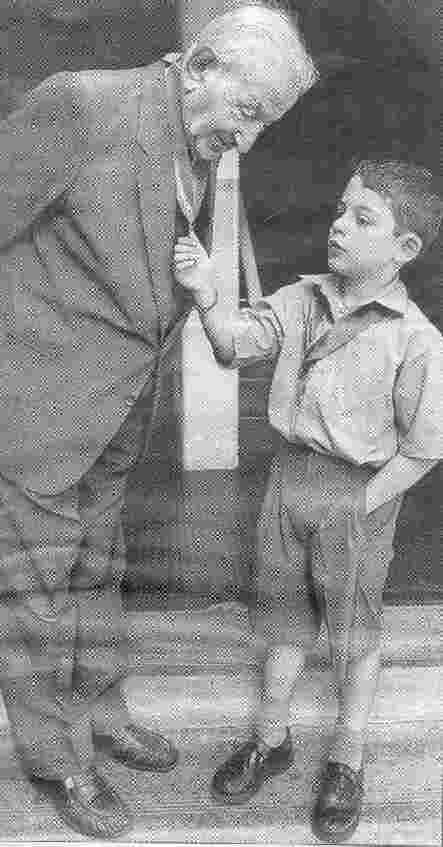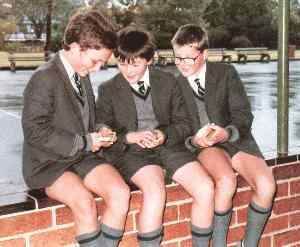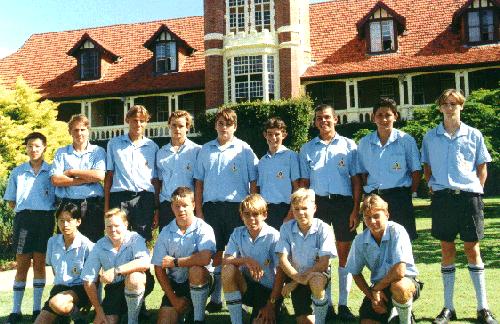
Australian School Uniforms: Types of School

Figure 1.--This 7 year-old student at an Australian state primary school in 1999 examines the medal of a former student. The picture indicates the closing of a boys school in the heart of the city after 130 years. The boy wears heavy-weight winter shorts with lining. These are only worn by the junior students and not the seniors. He also wears grey ankle socks. The shirt is a light blue short sleeve shirt.
|
School uniform standards tended to be different at the different schools, both age wise (elementary and secondary) and types (state, Catholic, and private). Uniform regulations at these different tupes of schools tend to be quite different. Generally the private schools, especially the traditional ones based on English public and preparatory schools give much greater attention to uniforms than than the state schools. Even so, most Australian state schools do require uniforms, although the uniform can be very basic--especially at state elementary schools.
I am not sure how Australian elementary children dresses for school in the 19th and early 20th centuries. I think that uniforms were generally not required, but have little information. Elementary children at state schools have generally wore shorts and knee socks to school since the 1920s. Many elementary schools currently require uniforms. Often the regulation is short pants in the summer and long pants in the winter. Often a sweater ("jumper") or sweat shirt is worn as part of the uniform. Blazers and ties are rarely required. Many secondary schools followed English dress standards through the 1950s. It was not uncommon for state secondary schoolboys to wear caps, ties, blazers, shorts, and knee socks. The academically selective grammar school tended to have the strictest dress codes as they often attempted to emulate the ethos of the English public school. This began to change in the 1950s and especially the 1960s. Some state secondary schools dropped uniform requirements all together. Most
retained a basic uniform. Currently uniforms continue to be common. Many schools have a summer and winter uniform. Often shorts are worn in the summer term. Some schools require knee socks, but many do not. The styles are currently much more casual than in earlier years. Open neck shirts are most common and ties are now rarely worn.
Catholic Schools
Austrlaia has one of the largest non-state school systems in the world, the large Catholic system. The Irish came to Austrlaia as the colonization of the country coincided with the disastrous potato famine of the 1840s. As in the United States and other countries, Catholic prelates with considerable justification, were suscpious of the predominately protestant character of the developing state schools. As a resuly, they built an entirely separate dschool system. Catholic schools in Australia, however, were eventually able to obtain state funding supplements, unlike the Catholic schools in the United States. I have no information of dress standards at Catholic elementary schools during the 19th and early 20th centuries. I believe, however, that by the 1920s-30s most Catholic children were wearing school uniforms. The uniforms were similar to those at state schools, sweaters (in the winter), grey shorts, and knee socks. Generally speaking uniform standards are stricter at the Catholic schools. I'm not sure about ties or caps. Most Catholic elementary schools continue to require uniforms, mostly sweaters, short pants, and knee socks. I have little information on dress standards during the 19th and early 20th century at Australian Catholic secondary schools. Most by the 1920s were requiring English style uniforms. Contemporary schools still insist on uniforms and standards are stricter than at the state schools. One correspondent in the 1960s described his uniform of blazer, white, shirt, tie, grey short pants, and knee socks. The shorts were optional, but many boys wore them. Often the parents decided.
Private Schools
There are various types of priavate schools in Australia. The major ones have been those established along the lines of the English public and preparatory schools. It is sometimes difficult to tell by the name of the school. Grammar schools in England and New Zealand, for example, are usually state secondary schools. Many Australian grammar schools are private secondary schools. Since the 1980s many new schools similar to American fundamentalist Christian schools have also been formed. There are significant differences in the uniform worn at these schools.
Garments
Private schools both elementary and secondary tended to follow Engish uniform standards and this has continued to the current period. Private schools are much more likely in Australia to require a formal uniform. As the pribate schools (especially preparatory schools and the traditional private secondary schools) in Australia are 'elitest' schools, they pride themselves in the more traditional English boys uniform. Both parents and administrators at these schools tend to think it important for the boys to "look smart". In many private schools, the cost of a uniform may be 10 times the cost in a comparable state school. There have been some important changes over time in the uniforms worn at even the traditional private schools.
Caps: Virtually all Australian private schools required the traditional English peaked caps through the 1950s. A fewe schools required the straw boater instead of the peaked cap. The fashion of wearing caps wained, and school caps began to disapear in the 1960s. By the 1980s only a handful of private schools still required them. A few schools still do require caps. Some still wear boaters, at least as part of the dress uniform. Some schools have introduced hats in a modified bush hat style. An Australian school in Singapore, for example, uses this style for boys.

Figure 4.--Some Australian private schools use grey suits as a uniform instead of the blazers used at most schools.
|
Blazer: Blazers are still worn at most traditional Australian private schools. A great variety of colors or worn, but usually solid
colors. Some have edging in comtrasting colors. Some schools have grey suits rather than blazers.
Tie: Australian private schools continue to require ties like the ones at English schools. Both the elementary and secondary private schools generally require them. The ties were usually stripped in the school colors. Often prefects or boys who "won their colors" received the honor of wearing distinctive colors.
Shirt: The standard school boy shirt after Eton suits disappeared during the 1930s were grey straight collared shirts. For dress occasions a white shirt was substituted. Some elementary schools in recent years have intoduced more casual white or blue polo-style shirts.
Trousers: Private elementary schools henerally required shorts as did the secondary schools through the 1950s. Most private elementary schools still require shorts and knee socks. A few of the private secondary schools may require shorts for the younger boys, but most of the secondary school uniforms are now long pants.
Shoes: Elementary-age boys sometimes wore closed-toe brown "T" strap sandals, referred to as school sandals, for normal school wear. Some younger boys or girls wore redish-brown or blue sandals or double strap sandals. This style was, however, never as common in Australia as England. Boys at private schools today generally wear black oxfords.

Figure 5.--These year 10 boys at an Australian private school wear a commfortable summer uniform which still shows a British influence.
|
Socks Boys wearing shorts generally wore grey knee socks, or turn-over-top socks as the British might say. Knee socks are still worn by many boys wearing shorts even durng the warm summe term. This shows the British influence where jnee socks were needed by boys wearing short pants during the cold winter weather. Some school pemit ankle socks (or sandals and no socks) during the summer. Many schools had socks with the school colors at the top band, but many boys wore plain grey knee socks. English boys never wore white socks, except for cricket, as white socks, both ankle and knee socks, were generally worn by girls and thus seen as girls' socks. A few Austrlaian schools, however, did introduce white or light blue knee socks.
Additional Information
Related Links: Careful this will exit you from the Boys' Historical Clothing web site, but both sites are highly recommended
Apertures Press New Zealand book: New book on New Zealand schools E-book available
Boys' Preparatory Schools: Lovely photographic essay of British preparatory schools with some over 200 color and black and white photographs depicting the schools during the 1980s
New British preparatory schools E-book in preparation
HBC-SU

Related Chronolgy Pages in the Boys' Historical Web Site
[Main Chronology Page]
[The 1880s]
[The 1930s]
[The 1940s/a>]
[The 1950s]
[The 1960s]
[The 1970s]
[The 1980s]
Related Style Pages in the Boys' Historical Web Site
[Main school uniform page]
[Main country page]
[Long pants suits]
[Short pants suits]
[Socks]
[Eton suits]
[Jacket and trousers]
[Blazer
[School sandals]
Navigate the Boys' Historical Clothing School Uniform Pages
[Main School Uniform Page]
[Main Australia page]
[England]
[France]
[Germany]
[Italy]
[Japan]
[New Zealand]
[Scotland]
[United States]
Created: April 25, 1998
Last updated: 12:00 AM 8/9/2004






